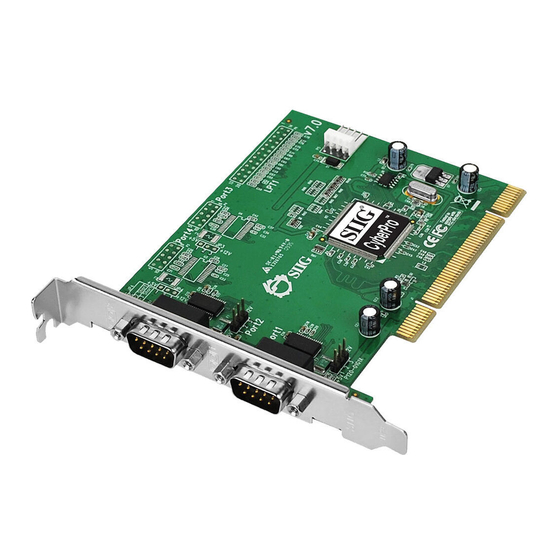
SIIG CyberSerial Dual PCI Quick Installation Manual
Hide thumbs
Also See for CyberSerial Dual PCI:
- Software installation (9 pages) ,
- Quick installation manual (12 pages) ,
- Quick installation manual (12 pages)
Advertisement
Quick Links
Introducing the CyberSerial Dual PCI
The CyberSerial Dual PCI high-speed serial I/O card
provides two additional 9-pin serial ports.
Features and Benefits
•
Conforms to PCI v2.2 Plug and Play
•
Reduces CPU load and improves system
performance dramatically
•
IRQ sharing feature reduces IRQ conflicts
•
High-speed serial port (9-pin) works with 56K V.90
external modems, ISDN terminal adapters, PDAs,
digital cameras, label printers and other serial port
devices
•
Built-in FIFO buffers dramatically increase data
transmit/receive speed, especially under Windows'
multitasking environment
•
Each serial port can be configured for either 5V or
12V output, for serial devices that require power
System Requirements
•
Pentium
PCI slot
•
Windows
(32-/64-bit) / Server 2003 & 2008 (32-/64-bit) / 2000
/ NT 4.0 / ME / 98SE / 98 / 95; DOS
•
Linux Kernel 2.4.x or later
04-0375C
CyberSerial Dual PCI
Quick Installation Guide
or equivalent computer with an available
®
7 (32-/64-bit) / Vista (32-/64-bit) / XP
®
1
Advertisement

Summary of Contents for SIIG CyberSerial Dual PCI
- Page 1 CyberSerial Dual PCI Quick Installation Guide Introducing the CyberSerial Dual PCI The CyberSerial Dual PCI high-speed serial I/O card provides two additional 9-pin serial ports. Features and Benefits • Conforms to PCI v2.2 Plug and Play • Reduces CPU load and improves system performance dramatically •...
-
Page 2: Package Contents
Package Contents • CyberSerial Dual PCI board • Driver CD • Quick installation guide Layout JP2 (Serial port 2) Serial Port 2 JP1 (Serial port 1) Serial Port 1 Figure 1. Layout Jumper Settings (JP1, JP2) Open = 0 volts (default) -
Page 3: Hardware Installation
Hardware Installation General instructions for installing the card are provided below. Since the design of computer cases and motherboards vary, refer to your computer’s reference manual for further information, if needed. Static Electricity Discharge may permanently damage your system. Discharge any static electricity build up in your body by touching your computer’s case for a few seconds. -
Page 4: Driver Installation
Driver Installation This section provides information on how to install the CyberSerial Dual PCI drivers. Windows 7 (32-/64-bit) Right click Computer, click Manage, click Device Manager. Insert the driver CD. Right click PCI Serial Port, click Update Driver Software. Click Browse my computer for driver software. - Page 5 Repeat step 2 to complete the driver installation. Note: Windows Vista driver installation process may take several minutes to complete. Windows XP (32-/64-bit) / Server 2003 (32-/64-bit) At the Found New Hardware Wizard, insert the driver CD. Select No, not this time, click Next. (Skip this step if not prompted) Select Install the software automatically (Recommended), then click Next.
- Page 6 For Server 2008: Right click Computer, click Manage, double click Diagnostics, then click Device Manager. Click on the + (plus sign) in front of Ports (COM & LPT), CyberSerial 16Cxxx... should be displayed two times. Double click Multifunction adapters, SIIG CyberPro 2S board should be displayed.
- Page 7 Windows ME At the Add New Hardware Wizard, select Specify the location of the driver (Advanced), click Next. Insert the driver CD, check Specify a location, uncheck the other box, type in D:\ME, then click Next. (Change D: to match your CD/DVD-ROM drive letter) Click Next, then Finish.
- Page 8 Right click My Computer, click Properties, then click Device Manager. Double click Ports (COM & LPT), CyberSerial PCI 16Cxxx... should be displayed two times. Double click Multi-function adapters, SIIG CyberPro 2S... and PCI Function should be displayed. Windows NT 4.0 From the desktop click Start, then Run.
- Page 9 Linux Kernel 2.4.x or later Open the terminal. Type setserial -bg /dev/ttyS* and hit <enter> to show the current serial ports installed. SIIG board will be set up at the next available address. For example, if your system comes with /dev/ttyS0 and /dev/ttyS1, set up SIIG board as /dev/tty2 and /dev/ttyS3.
- Page 10 Edit the startup file and add these two command lines at end of the startup file. - setserial /dev/ttyS2 port 0xa000 irq 9 uart 16950. - setserial /dev/ttyS3 port 0xa008 irq 9 uart 16950. Note: ttyS value, I/O port address and irq should be different from one system to another.
-
Page 11: Technical Support And Warranty
Step 1: Submit your RMA request. Go to www.siig.com, click Support, then RMA to submit a request to SIIG RMA. If the product is determined to be defective, an RMA number will be issued. Step 2: After obtaining an RMA number, ship the product. - Page 12 Fremont, CA 94538-3152, USA Phone: 510-657-8688 CyberSerial Dual PCI is a trademark of SIIG, Inc. SIIG and the SIIG logo are registered trademarks of SIIG, Inc. Microsoft, Windows and Windows Vista are either registered trademarks or trademarks of Microsoft Corporation in the United States and/or other countries. Pentium is a registered trademark of Intel Corporation.










Need help?
Do you have a question about the CyberSerial Dual PCI and is the answer not in the manual?
Questions and answers